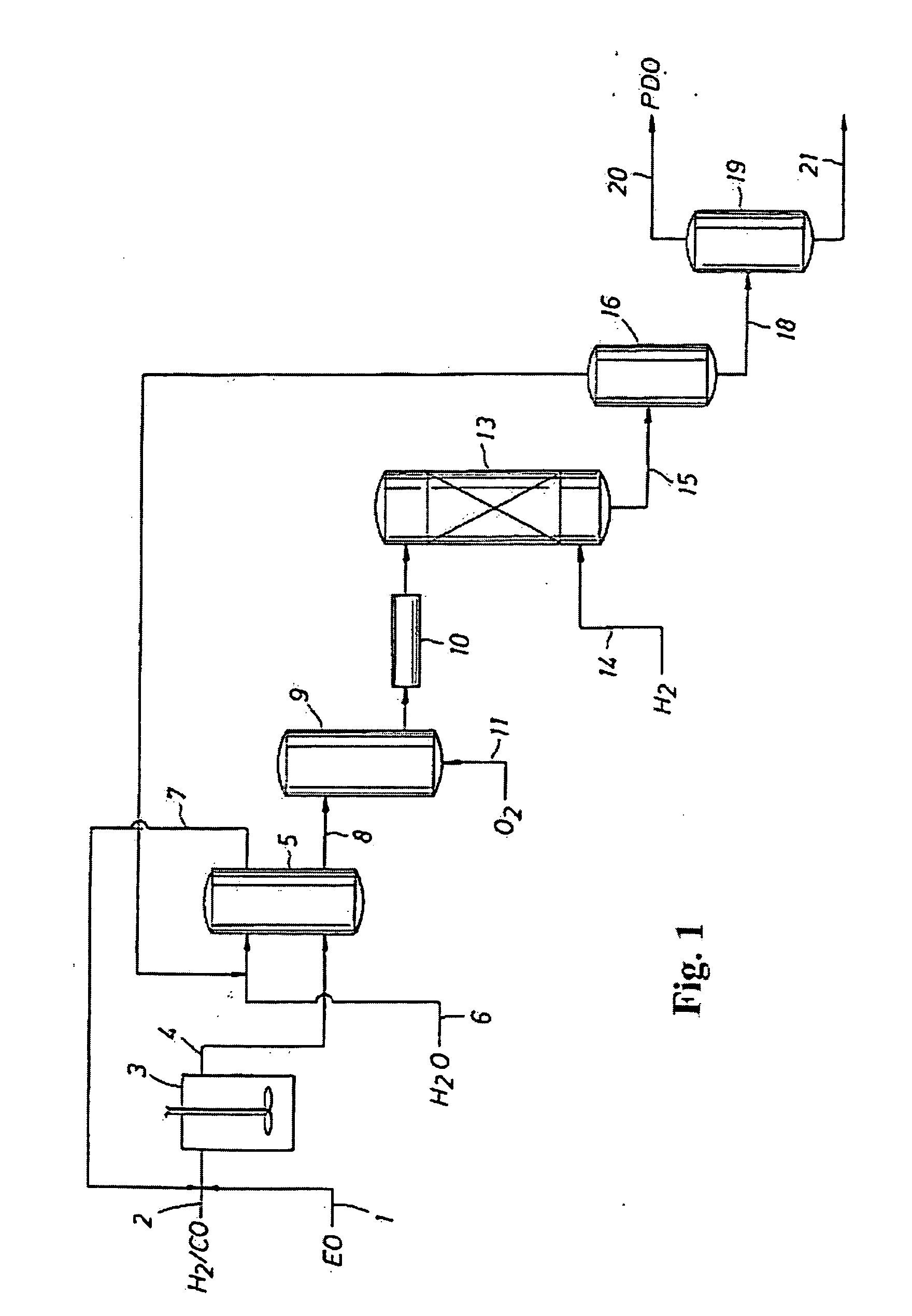Treatment of an aqueous mixture containing an alkylene oxide with an ion exchange resin
a technology of ion exchange resin and alkylene oxide, which is applied in the preparation of hydroxy compounds, chemistry apparatus and processes, and organic chemistry, etc., can solve the problems of ethylene oxide binding significantly impairing the efficiency of the resin, oxide fouling reducing the ion exchange capacity to near zero, and -biodegradable pollutan
- Summary
- Abstract
- Description
- Claims
- Application Information
AI Technical Summary
Problems solved by technology
Method used
Image
Examples
example 1
[0052] The effectiveness of a carboxylic acid ion exchange resin to remove water-soluble cobalt from an aqueous solution containing HPA, water-soluble cobalt, and ethylene oxide and to be regenerated without the production of dioxane in accordance with a process of the invention was determined. An aqueous solution containing 12.7 wt. % HPA and 78 ppm cobalt was doped with excess ethylene oxide (EO) to an EO concentration of 4.8 wt. %. The aqueous solution was doped with EO to obtain a mixture that would foul a carboxylic acid ion exchange resin quickly with EO. 0.7 grams (dry) of a carboxylic acid ion exchange resin (IRC76 from Rohm & Haas) were contacted with 14-16 grams of the EO-enhanced aqueous solution in a vial sealed with a septum, and rotated on a rotating rack for 15 hours at 25° C. The solution was then separated from the resin by filtering the resin on a vacuum filter funnel, followed by water washing the resin. The separated solution, including the water washes, was then...
example 2
[0054] A series of experiments were conducted to determine whether 1,4-dioxane would be formed during separation of a water soluble cobalt species from an aqueous solution containing ethylene oxide over various carboxylic acid ion exchange resins and under varying subsequent acid regeneration conditions of the carboxylic acid ion exchange resins, where the process utilized in the experiments was conducted in accordance with an embodiment of the process of the present invention. An aqueous solution containing HPA and a water soluble cobalt species was produced from the hydroformylation of ethylene oxide and syngas in the presence of a cobalt carbonyl catalyst in a methoxy-t-butyl ether solvent, followed by aqueous extraction of the hydroformylation reaction mixture, and separation and air oxidation of the aqueous extract. The aqueous solution was doped with excess ethylene oxide to concentration of between 5 wt. % and 15 wt. % ethylene oxide to accelerate fouling of the ion exchange ...
example 3
[0056] For comparative purposes, a series of experiments were conducted to determine whether 1,4-dioxane would be formed in separating a water soluble cobalt species from an aqueous solution containing ethylene oxide over a strong sulfonic acid ion exchange resin and subsequent acid regeneration of the sulfonic acid ion exchange resin and separation of a spent acid wash from the regenerated resin—a process not encompassed by the process of the present invention. Samples were prepared and analyzed as disclosed in Example 2 above, except that A-15, a strong sulfonic acid ion exchange resin from Rohm & Haas, was used instead of a carboxylic acid ion exchange resin. The results are shown in Table 3.
TABLE 3TotalEO soakRegenerant %Regen.DioxaneSampleResinResin typetimeEO wt. %H2SO4Temp ° C.ppm1A-15macro50109002A-15macro511.810909973A-15macro511.810904994A-15macro511.809019435A-15macro306.8109014366A-15macro306.8108021197A-15macro605.010907851
[0057] The results show 1,4 dioxane formation...
PUM
| Property | Measurement | Unit |
|---|---|---|
| temperature | aaaaa | aaaaa |
| temperature | aaaaa | aaaaa |
| pH | aaaaa | aaaaa |
Abstract
Description
Claims
Application Information
 Login to View More
Login to View More - R&D
- Intellectual Property
- Life Sciences
- Materials
- Tech Scout
- Unparalleled Data Quality
- Higher Quality Content
- 60% Fewer Hallucinations
Browse by: Latest US Patents, China's latest patents, Technical Efficacy Thesaurus, Application Domain, Technology Topic, Popular Technical Reports.
© 2025 PatSnap. All rights reserved.Legal|Privacy policy|Modern Slavery Act Transparency Statement|Sitemap|About US| Contact US: help@patsnap.com

